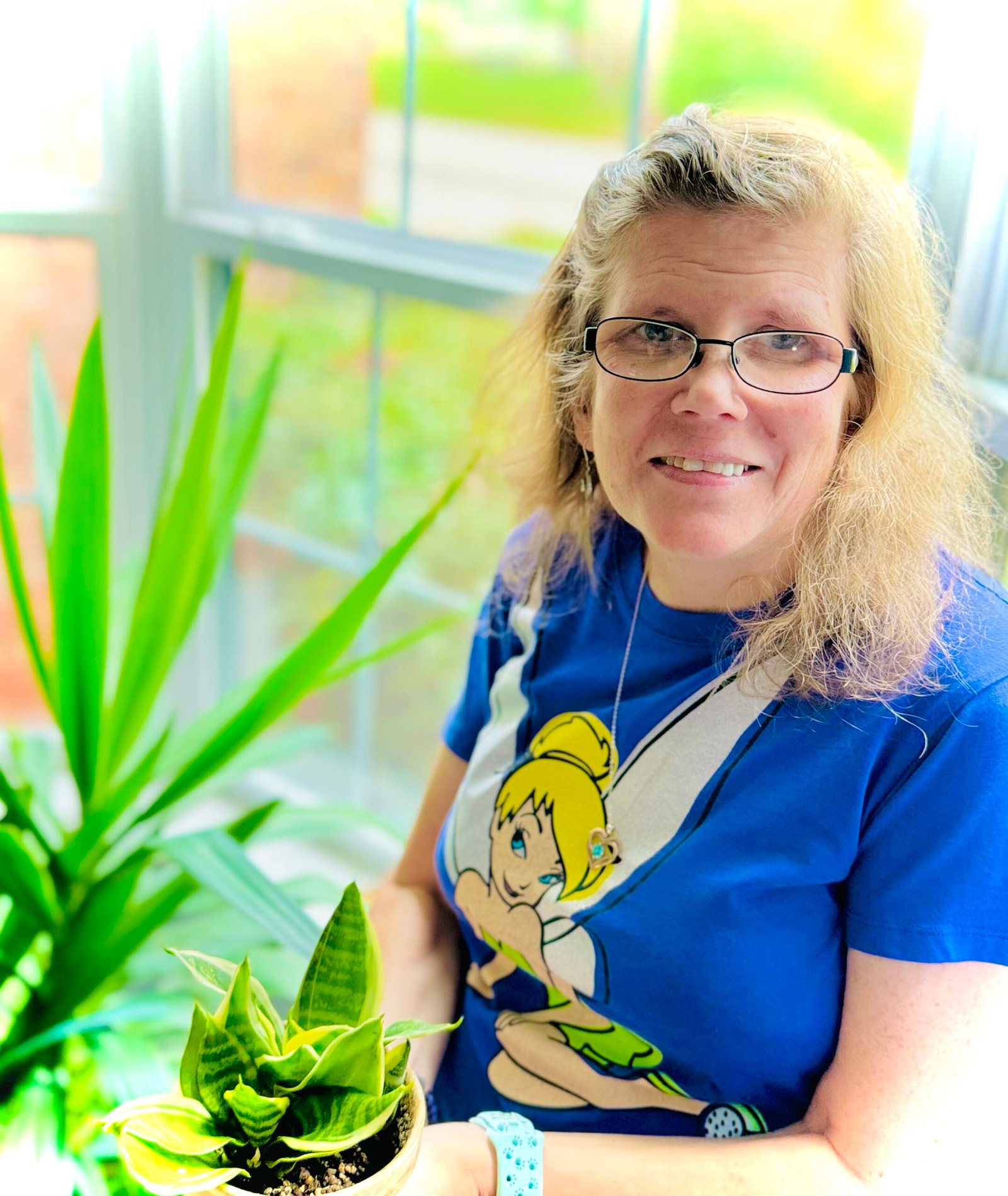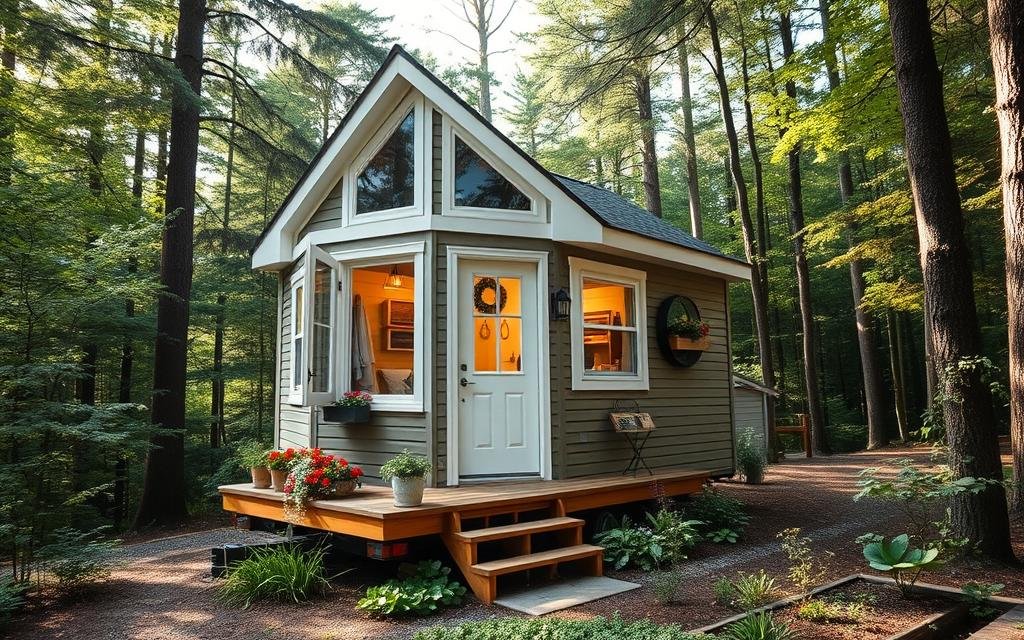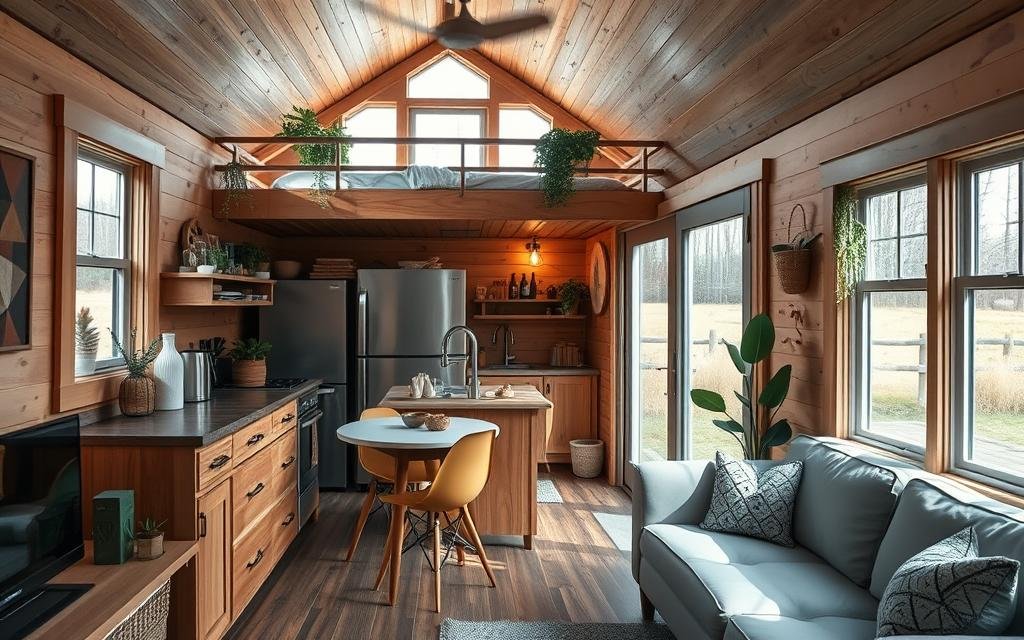Table Of Contents
The Pros and Cons of Living in a Tiny House: What You Need to Know for Your Next Move
Key Takeaways
- Benefits and Drawbacks of Compact Housing: Insights on Minimalist Living
- Positive Aspects of Small Home Life
- Negative Aspects of Small Home Life
- Elements to Think About Prior to Relocating to a Compact Dwelling
- Psychological and Emotional Factors of Small Home Living
- Crucial Advice for Residing in a Compact Space
The Pros And Cons Of Living In A Tiny House: What You Need To Know | Understanding Tiny House Living
The tiny house movement has gained significant traction, appealing to those seeking a simpler lifestyle through tiny house living. The Pros and Cons of Living in a Tiny House: What You Need to Know encompass both the allure and challenges of transitioning to a smaller space. Tiny homes often promote minimalism, encouraging residents to declutter and prioritize essentials. However, the limited space in tiny houses can lead to storage challenges, especially when fitting in necessary items like couches or appliances. Understanding the nuances of tiny house living is essential for those considering this lifestyle choice, ensuring that potential homeowners are fully prepared for the unique experience of living in a mobile home or a fixed tiny house.
The Pros and Cons of Living in a Tiny House: What You Need to Know | Definition and Key Features of a Tiny House
Tiny houses have become increasingly popular among homebuyers seeking alternatives to traditional living spaces. These compact homes typically measure less than 400 square feet, allowing for easy maintenance and lower cost of living. Many tiny houses feature innovative designs with lofts that serve as bedrooms, maximizing vertical space. The layout often includes multifunctional furniture, such as sofas that convert into beds or storage solutions that seamlessly integrate into the overall design, proving that less can indeed be more.
The tiny house movement emphasizes simplicity and minimalism, attracting those who wish to downsize from larger homes or mansions. Key features of a tiny house often include open floor plans and cleverly designed storage areas, sometimes replacing basements with efficient use of every square inch. Homebuyers are drawn to the appeal of living in a space that encourages a clutter-free lifestyle, promoting mindfulness and intentionality in everyday living. The Pros and Cons of Living in a Tiny House: What You Need to Know involves understanding these distinctive characteristics and what they mean for potential residents.
- Pros: Lower utility bills due to smaller space and energy efficiency.
- Pros: Encourages a minimalist lifestyle, reducing clutter and stress.
- Pros: Flexibility in mobility, allowing for travel or relocation with ease.
- Cons: Limited space can be challenging for families or individuals with many possessions.
- Cons: Lack of privacy, especially in shared living situations.
- Cons: May have restrictions based on zoning laws or property regulations.
- Cons: Less storage can require creative solutions and constant decluttering.
Overview of the Tiny House Movement
The tiny house movement has gained significant traction across the United States, driven by a desire for simplicity and financial freedom. Advocates highlight the appeal of downsizing and the ability to achieve one’s dream home without the burdens associated with traditional real estate. Many people are turning to RV-style tiny houses, which allow for mobility and flexibility, catering to those looking to sleep and live in less space while saving money.
Grassroots organizations and the National Association of Home Builders have supported this trend by addressing zoning laws and legal restrictions that often hinder tiny house living. The movement not only fosters a minimalist lifestyle but also encourages community-building among those who choose to embrace the benefits of living in smaller spaces. Understanding the pros and cons of living in a tiny house: what you need to know is crucial for anyone considering taking this step toward a more sustainable and fulfilling way of life.
The Advantages of Tiny House Living
Living in a tiny house presents a unique lifestyle that emphasizes simplicity and efficiency, appealing to many who embrace small house living. As with The Pros and Cons of Living in a Tiny House: What You Need to Know, tiny house pros such as reduced housing costs, lower utility bills, and a smaller environmental footprint attract potential tiny house owners. This minimalist approach encourages individuals to declutter and prioritize experiences over material possessions. However, it is essential to recognize tiny house cons, including limited space and potential zoning challenges that can impact one’s living experience. The balance of tiny living requires careful consideration of both its advantages and drawbacks, making it vital for individuals to assess what truly aligns with their lifestyle needs.
Financial Benefits of Living in a Tiny House
A tiny home brings numerous financial advantages that can be hard to overlook. The tiny house cost is often significantly lower than that of traditional homes, making it an appealing option for many. Tiny home dwellers usually face reduced monthly expenses in areas such as utilities, property taxes, and mortgage payments. This affordability allows tiny house owners to allocate their funds toward experiences like tiny house travel rather than being burdened by overwhelming debts.
Embracing tiny home thinking fosters a lifestyle that prioritizes simplicity and sustainability. Small homes typically require less maintenance and fewer resources, translating into lower ongoing costs. This financial freedom can lead to greater savings and eventually open doors to investments or traveling opportunities. The Pros and Cons of Living in a Tiny House: What You Need to Know emphasizes how this shift in mindset can lead to a more fulfilling and economically sound way of living.
Environmental Impact and Sustainability
The tiny house trend prioritizes sustainability and environmental consciousness. Tiny homes require fewer materials to build, resulting in reduced carbon footprints compared to traditional houses. For tiny home enthusiasts, this minimalistic approach not only means lower energy consumption but also encourages a more efficient use of resources. This lifestyle aligns well with the basic house philosophy, where every square foot is maximized for functionality and practicality, making tiny house prices more appealing to environmentally-minded buyers.
Tiny home-building projects often incorporate eco-friendly practices and materials, attracting dedicated tiny home homeowners. Many of these houses use renewable resources and promote green technologies, reflecting a commitment to sustainability. DIY-style builds allow individuals to customize their homes with energy-efficient appliances and sustainable designs. This focus on environmental impact makes tiny living a compelling option for those looking to make a positive change while enjoying the freedoms of a smaller, clutter-free space.
Minimalism and Decluttering Your Life
Embracing a tiny lifestyle encourages individuals to rethink their possessions and prioritize what truly matters. The Pros and Cons of Living in a Tiny House: What You Need to Know highlights how downsizing helps many people discard unnecessary clutter. Living in a smaller home naturally leads to a paradigm shift where less becomes more. Tiny living converts often discover that the space limitations within a tiny house foster creativity in storage solutions and organization. This journey towards minimalism can be liberating and promote a sense of peace, away from the chaos often found in a bigger home.
This process of decluttering not only frees up physical space but also brings mental clarity. The shift from a big home to a tiny house can initially feel daunting, sometimes even provoking fears of a tiny house horror scenario, but the rewards often outweigh the challenges. By learning to live with only essential items, individuals often strengthen their connection to their surroundings and enhance their overall well-being. Ultimately, the move towards a more simplified life opens doors to new experiences and deeper appreciation for the space we occupy in a whole house, big or small.
| Aspect | Pros | Cons |
|---|---|---|
| Space | Encourages minimal living and organization | Limited room for belongings and guests |
| Cost | Lower expenses and maintenance costs | Potentially higher cost per square foot |
| Environmental Impact | Less energy consumption and waste production | May not be suitable for everyone |
| Community | Strengthens connections with neighbors | May feel isolated in rural settings |
The Disadvantages of Tiny House Living
Living in a tiny house presents various challenges that can impact one’s quality of life. Space constraints often lead to difficult decisions regarding possessions, as tiny cabinets and limited storage can force residents to downsize significantly. This situation may lead to feelings of frustration, especially for those accustomed to larger living spaces filled with non-tiny things. Zoning laws and legal restrictions can complicate the home-building process for micro-homes, making it difficult to find suitable locations. The transition to a tiny town or portable homes can also require significant lifestyle adjustments, increasing the pressure on relationships and even resulting in situations like a tiny house divorce. Understanding The Pros and Cons of Living in a Tiny House: What You Need to Know is essential for anyone considering this unique living situation.

Limited Space and Storage Challenges
Living in a tiny space presents unique challenges, especially concerning limited storage options. Unlike a normal house or a single-family home, a tiny home requires residents to reassess their belongings. The Pros and Cons of Living in a Tiny House: What You Need to Know highlights the importance of prioritizing possessions, as every inch must serve a purpose. Many tiny home blogs showcase innovative storage solutions, yet the challenge remains to fit everyday items into a small footprint while maintaining a functional living environment.
The constraints of a tiny home can also affect daily living situations. A small residence may lack the traditional rooms found in larger homes, which can lead to feelings of overcrowding or disorganization. Families accustomed to the space of a large home might find the transition difficult. The Pros and Cons of Living in a Tiny House: What You Need to Know emphasizes the need for effective space management strategies to keep a tiny home comfortable and inviting. Balancing minimalism with storage solutions is crucial for anyone eager to thrive in a tiny living space.
Zoning Laws and Legal Restrictions
Zoning laws can pose significant challenges for potential homebuyers interested in the tiny home craze. Many local governments have established regulations that define what constitutes a residence, often emphasizing the size and structure of conventional homes. As a result, tiny houses may not meet these standards, making it difficult for individuals to find a suitable place for their small space. Understanding the rules governing land use is essential for anyone considering the transition to a tiny home. The Pros and Cons of Living in a Tiny House: What You Need to Know includes the necessity of navigating these legal complexities.
Legal restrictions vary widely from one area to another, impacting how tiny houses are classified and where they can be situated. Some municipalities may allow tiny homes on wheels as a mobile residence, while others may require them to be anchored to a foundation. This lack of uniformity can complicate the process for those looking to invest in a standard home alternative. Knowing the zoning ordinances not only helps in securing the right location but also ensures a comfortable living experience in your tiny home. The Pros and Cons of Living in a Tiny House: What You Need to Know highlights the importance of thorough research before making any decisions.
Potential Lifestyle Adjustments
Transitioning to a tiny house necessitates significant lifestyle adjustments for many people. The Pros and Cons of Living in a Tiny House: What You Need to Know reveals that moving from a huge house to a modest square foot house can challenge your perceptions of comfort and space. Homeowners often find that downsized living means re-evaluating what is truly necessary. The impact of having limited room encourages meaningful choices about belongings, which can be a positive shift for many seeking a simpler lifestyle.
Living in a small home often prompts a reevaluation of daily routines and activities. A square foot house can feel cramped, and you may need to adapt how you utilize shared spaces to mitigate the potential problem living in tight quarters. This adjustment period might mean prioritizing outdoor activities or exploring community amenities. Understanding The Pros and Cons of Living in a Tiny House: What You Need to Know can help mitigate challenges as you embrace a new way of life that values experiences over possessions.
Assessing Your Lifestyle Needs
Before making the leap into tiny house living, evaluating your lifestyle needs is crucial. The Pros and Cons of Living in a Tiny House: What You Need to Know emphasizes the need to assess how a smaller space will align with your daily activities and routines. Unlike traditional housing, tiny homes require homeowners to reconsider their use of space. An average home may afford a level of comfort and storage that a tiny house cannot, making it essential to prioritize what household items are truly necessary.
Understanding the trade-offs associated with downsizing can help inform your decision. Implementing multi-purpose furniture and optimizing every square inch of your residential property becomes a necessity. Homeowners should consider their long-term goals and whether a legal housing structure aligns with them. The decision to switch from traditional housing to a tiny house should reflect not only immediate needs but also future aspirations.
The Importance of Location
Choosing the right location is crucial for anyone considering the transition to tiny house living. The Pros and Cons of Living in a Tiny House: What You Need to Know emphasizes the balance between affordability and lifestyle. In areas with expensive homes, a tiny masterpiece can offer an alternative, allowing homeowners to maximize their interior while minimizing household stuff. A good location should not only provide access to essential amenities but also align with personal space preferences and community dynamics.
Proximity to urban centers or nature can significantly impact the quality of life. Homeowners often find that living in a tiny house near vibrant communities enhances their daily experiences. Those accustomed to traditional homes might need to rethink their expectations regarding indoor space and local offerings. Understanding The Pros and Cons of Living in a Tiny House: What You Need to Know will help prospective residents make informed decisions that suit their lifestyle and personal aspirations.
- Consider availability of essential services like grocery stores and healthcare.
- Look for areas with a strong sense of community and support networks.
- Evaluate the local climate to ensure it fits your lifestyle preferences.
- Research zoning laws and regulations related to tiny houses in the area.
- Think about access to recreational opportunities like parks and trails.
- Choose a location that allows for future growth and development.
- Don’t forget to consider the resale value and market trends of the area.
Resale Value and Market Trends
Understanding the resale value and market trends of tiny houses is crucial for potential buyers. The Pros and Cons of Living in a Tiny House: What You Need to Know includes recognizing that the small size of these homes can influence their appreciation over time. While some buyers are drawn to the simplicity and lower housing costs associated with tiny living, others may find it challenging to resell a home that offers fewer amenities and limited space for little luxuries. Current trends show a growing interest in tiny houses, but the fluctuating market can impact how well a resale goes.
Potential homeowners should consider how the unique aspects of tiny housing affect marketability. For those who have lived in their time home for several years, tiny storage compartments may become both a blessing and a curse. With few things to store, it may feel easier to downsize, yet the limited options can complicate the resale process. As buyers assess their needs, understanding the dynamics of the tiny house market becomes essential. The Pros and Cons of Living in a Tiny House: What You Need to Know helps navigate this evolving landscape.
The Emotional and Mental Aspects of Tiny House Living
Embracing the tiny house lifestyle can significantly impact the emotional and mental well-being of residents. Many find that downsizing from a traditional home allows them to focus on what truly matters, reducing the stress associated with excessive possessions and the pressures of maintaining a larger space. Living in a smaller environment encourages a minimalist mindset, where individuals prioritize their needs and let go of luxurious conveniences that contribute little to their happiness. This shift can foster a sense of community, especially in tiny house neighborhoods, as residents navigate challenges together amid growing housing shortages. Understanding The Pros and Cons of Living in a Tiny House: What You Need to Know helps prospective dwellers evaluate their choices in the context of the current housing market, leading to more fulfilling living experiences.

Building Community in Tiny House Environments
Tiny house living often fosters a strong sense of community among dwellers. With limited space and a focus on minimalism, individuals may find they are more inclined to share resources and collaborate with neighbors. This situation can help people let go of certain possessions, as they rely on communal facilities like shared garages. Understanding The Pros and Cons of Living in a Tiny House: What You Need to Know helps potential residents appreciate the benefits of social connections that arise in these tight-knit environments.
The Canadian home size trend often emphasizes the benefits of downsizing and living within a community. Rent costs can be significantly reduced, allowing more freedom to connect with others within the tiny house community. While some may view having less personal space as a con, many find that the relationships formed through sharing and togetherness more than compensate for it. A supportive network can enhance the tiny house experience, encouraging a lifestyle focused on collaboration and shared values.
Managing Stress and Space Constraints
Living in a tiny house can be a dream life for many, but it also presents certain challenges that can lead to stress. The limited space forces residents to make tough decisions about their possessions, often prompting them to rethink the things they truly need. With careful planning, it is possible to create an environment that aligns with one’s personality, incorporating certain decor and even optimizing furniture like sofa cushions for comfort and utility. Recognizing the pros and cons of living in a tiny house is crucial for anyone considering this lifestyle.
Adapting to such a compact environment requires mindfulness about how space is utilized. Finding innovative solutions for storage and organization is essential to keep stress levels low. The decision to downsize means letting go of excessive belongings while focusing on what is truly important. Embracing a minimalist mindset allows individuals to alleviate the cons of tiny house living, ensuring that their space becomes a sanctuary rather than a source of anxiety.
Essential Tips for Living in a Tiny House
Living in a tiny house brings unique challenges that require thoughtful strategies, especially regarding space management. Understanding The Pros and Cons of Living in a Tiny House: What You Need to Know is crucial for anyone considering this lifestyle. One key tip is to embrace innovative storage solutions to maximize every inch of your home. This can help you store your family’s belongings effectively while minimizing clutter. As you adapt to living in new places, you might find that multifunctional furniture can serve multiple purposes, allowing you to create a functional yet comfortable environment. By focusing on your wants and needs, you can create spaces that feel well-organized, enhancing your overall experience in tiny living.
Smart Storage Solutions
Effective storage solutions are crucial for maximizing the limited space in a tiny house. Innovative design techniques can transform everyday items into functional storage spaces. Creative shelving, under-bed storage, and multi-purpose furniture are just a few of the strategies that highlight the pros of living in a tiny house. Understanding these concepts can greatly enhance your experience and help you navigate the challenges outlined in The Pros and Cons of Living in a Tiny House: What You Need to Know.
Choosing the right storage solutions can also help maintain a clutter-free environment, which is essential for mental well-being. By prioritizing organization and function, tiny house dwellers can create a harmonious living space that reflects their lifestyle. Knowing how to effectively store belongings can alleviate some of the stress associated with limited space. Exploring these storage options is an essential aspect of The Pros and Cons of Living in a Tiny House: What You Need to Know.
| Storage Solution | Description | Benefits |
|---|---|---|
| Under-Bed Storage | Utilizing the space under the bed with bins or drawers. | Maximizes hidden space, keeps items out of sight, and is easy to access. |
| Wall-Mounted Shelves | Installing shelves on walls to display items and store books. | Creates vertical storage, frees up floor space, and adds decor style. |
| Multi-Purpose Furniture | Furniture that serves more than one function, such as a sofa bed or ottoman with storage. | Saves space, reduces clutter, and enhances functionality. |
| Over-the-Door Organizers | Hanging organizers that fit over doors for small items. | Utilizes often-wasted space and keeps essential items easily accessible. |
Conclusion
The Pros and Cons of Living in a Tiny House: What You Need to Know reveals valuable insights into the world of tiny house living. While tiny house pros such as financial savings and environmental benefits attract many, tiny house cons like limited space and legal restrictions can pose significant challenges. Small house living encourages a minimalist lifestyle, enabling tiny house owners to declutter and focus on what truly matters. However, potential buyers should carefully assess the implications of tiny living, as understanding the balance between tiny houses cons and the advantages is crucial for a fulfilling downsized lifestyle. Embracing tiny home living requires adaptability and a proactive approach to navigating the unique aspects that come with a smaller living environment.
FAQS
How do tiny house owners manage their space when a tiny house isn’t suited for traditional furniture?
Tiny house owners often utilize creative storage solutions and DIY-style furniture to maximize space since a tiny house isn’t designed for conventional arrangements. This means they have to adapt their living spaces, ensuring every inch of their homes is functional. In a tiny house, small doesn’t mean cramped; rather, it requires thoughtful organization and innovative design to create a home that feels comfortable and efficient. Additionally, many tiny home spreads emphasize multipurpose items, letting homeowners live in a smaller-sized home without sacrificing style or utility. Such adaptations reflect a current home building trend where modern designs cater to those wanting to live in small spaces while ensuring there’s enough space for essentials like sofas and cushions, making the entire home feel inviting.
What factors should a tiny home owner consider when deciding if a tiny house is the right choice for their lifestyle?
When considering if a tiny house is suitable for you, it’s important to reflect on what you want to live in. Tiny house forces you to adapt to a smaller amount of space compared to an average size house. If you’re used to the normal home experience, tiny houses may require significant adjustments regarding the furnishings you choose. Homeowner considers the average house size and the different room usages, like using multifunctional furniture instead of regular home setups such as large sofas and cushions, to maximize living efficiency in a tiny home DIY-style.
What challenges do tiny home owners face when choosing furniture for their tiny houses?
Tiny home owners often encounter unique challenges when selecting furniture for their tiny houses. Given the limited space, you’ll need to choose furnishings that serve multiple purposes and fit well within your residences. For example, instead of traditional sofas, homeowners might opt for compact, multifunctional sofas cushions that can also serve as storage or beds, ensuring that every small amount of space is utilized efficiently. This approach not only maximizes your living area but also helps create a cozy and functional environment in your tiny home.
What are the key considerations for homeowners thinking about whether tiny houses are a suitable living arrangement for you when you live in one?
When you live in tiny houses, there are several things homeowners must consider. These include the limited space, the impact on your lifestyle, whether you’re comfortable scaling down your possessions, and how this living arrangement aligns with your needs and priorities. Understanding these factors will help you determine if a tiny house is the right thing for you.
What are some common things homeowners should know about tiny houses before deciding if you’re ready to live in one?
Before you decide if tiny houses are right for you, there are several important things homeowners should consider, such as space efficiency, zoning laws, and your lifestyle needs. Understanding these factors can help you make an informed choice about whether you’re ready to embrace the unique living arrangements that tiny houses offer.
What are some key things homeowners should consider about tiny houses before deciding if you’re ready to live in one?
When contemplating tiny houses, there are several key things homeowners should reflect on, such as the space limitations and how those houses might impact your daily living. Additionally, it’s important to understand the financial implications, zoning laws, and how you’re going to adapt your lifestyle to fit into a smaller home.
What are some important things homeowners should consider about tiny houses before deciding if you’re ready to live in one?
When considering tiny houses, homeowners should think about various aspects such as space efficiency, lifestyle adaptability, and financial implications. Understanding how tiny houses suit your needs and the things homeowners often overlook can significantly impact whether you’re truly ready to commit to living in one.
What important aspects should homeowners think about regarding tiny houses before determining if you’re truly prepared for that lifestyle?
When contemplating tiny houses, homeowners should evaluate factors like space optimization, potential zoning restrictions, and the long-term commitment required. These considerations will help ensure that you’re making an informed decision about living in tiny houses while understanding the lifestyle changes they entail.
What are some essential things homeowners should recognize about tiny houses before concluding if you’re prepared for such a lifestyle?
Before concluding if you’re prepared for living in tiny houses, there are several essential things homeowners should recognize. Getting familiar with the unique design, space constraints, and the lifestyle adjustments required for tiny houses can significantly impact your decision. It’s important to assess how these factors align with your personal needs and if you’re ready to embrace this minimalist way of living.
What are some key reasons homeowners should consider living in tiny houses before deciding if you’re ready for a minimalist lifestyle?
Homeowners should recognize several advantages of tiny houses such as lower costs, reduced environmental impact, and simpler living. However, considering tiny houses means understanding the fundamental lifestyle changes you’ll face and whether you’re prepared for such adjustments, including decluttering “things” and maximizing space. Thus, you’re encouraged to evaluate these factors carefully before making a commitment.


